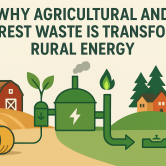Biogas Digester Units in Europe: An Overview
Europe is a global leader in the adoption and innovation of biogas technology, with biogas digester units playing a crucial role in the continent’s transition to renewable energy and circular economy practices. These units convert organic waste—such as agricultural residues, food waste, and sewage—into biogas, a renewable energy source, and digestate, a nutrient-rich fertilizer.
How Biogas Digester Units Work
A biogas digester unit operates through anaerobic digestion, a biological process where microorganisms break down organic matter in the absence of oxygen. The process occurs in sealed tanks called digesters, producing biogas (primarily methane and carbon dioxide) and digestate. The biogas can be used for electricity generation, heating, or as a vehicle fuel, while the digestate is often used as a biofertilizer.
The European Landscape
- Germany: The PioneerGermany is Europe’s largest producer of biogas, with thousands of biogas plants across the country. The German government has supported the sector through feed-in tariffs and subsidies, making biogas a significant part of its renewable energy mix.
- Italy and the UK: Growing MarketsItaly and the United Kingdom have also seen substantial growth in biogas production, driven by supportive policies and the need to manage organic waste sustainably. In the UK, biogas is increasingly used to generate electricity and heat, as well as to produce biomethane for injection into the gas grid.
- Scandinavia: Innovation and IntegrationCountries like Denmark and Sweden are known for their innovative approaches, integrating biogas production with district heating systems and public transport. Sweden, for example, has a well-developed network of biogas-powered buses and cars.
Benefits of Biogas Digester Units
- Renewable Energy: Biogas reduces reliance on fossil fuels and contributes to the EU’s renewable energy targets.
- Waste Management: It provides a sustainable solution for organic waste, reducing landfill use and greenhouse gas emissions.
- Circular Economy: The digestate can replace chemical fertilizers, closing the nutrient loop in agriculture.
- Energy Independence: Local biogas production enhances energy security and reduces dependence on imported fuels.
Challenges and Future Outlook
Despite its benefits, the biogas sector faces challenges such as high initial investment costs, regulatory hurdles, and the need for better infrastructure. However, ongoing technological advancements and increasing political support are expected to drive further growth.
The European Union’s Green Deal and the Fit for 55 package, which aim for climate neutrality by 2050, are likely to boost the biogas sector. With continued innovation and policy support, biogas digester units will remain a cornerstone of Europe’s sustainable energy future.




